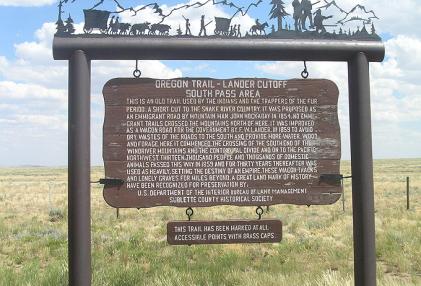- Home
- Field Trips
- Lander Trail
Lander Trail
The Lander Trail parallels a series of county roads across public and private land from Wyoming Highway 28 near South Pass, along the southern edge of the Wind River Range, to U.S. Highway 191 about 40 miles north of Farson. From there, it parallels Wyoming Highway 351 for about 25 miles, runs through Big Piney, Wyo., crosses Big Piney Creek and the Wyoming Range and finally crosses Star Valley on the Idaho border and into Idaho.

If you plan to visit the Lander Trail in Wyoming, get ready for spectacular scenery and often difficult road conditions. Traveling state Highway 28 to South Pass, you’ll find a turnout with interpretive materials where the Lander Trail crosses this modern road. You can travel in the actual trail ruts to the east but soon will encounter private lands and difficult, if not impassible, drainage crossings. Always obtain permission prior to accessing private lands.
To the west, you’ll encounter a series of county roads—Fremont County Route 446 and Sublette County Routes 132, 118, 133 and 113—that cross the trail in several places. Most crossings on these county roads are marked by concrete Lander Trail markers. Visitors can follow and intercept the trail and absorb the stunning landscape, much the same as it was at the time of its construction; however, this is now in an area that is a mixture of public and private ownership. Another interpretive site is found near Buckskin Crossing, which was a difficult ford for emigrants. There are graves and interpretive materials. The trail continues west past Buckskin Crossing for several miles, occasionally obscured by modern dirt roads. Follow the concrete and sometimes wooden markers to stay with the trail.
The Lander Trail sometimes is within BLM, U. S. Forest Service, county, U.S. Highways, state Highways and private roads, with intact segments often located near these modern arteries. Frequently, the trail is reachable as it intersects more user-friendly modern roads.
To the west of its intersection with U.S. Highway 191 the trail becomes difficult to follow. Expansive gas field development has compromised many segments and made others difficult to experience. Washed out stream crossings, steep terrain, vegetation, wide expanses of mud or dust, depending on the weather, and road segments that have changed from ruts into streambeds can make for uncertain travel. A high clearance, four-wheel drive vehicle is necessary on much of the remaining Lander Trail.
In recent years the Sublette County Historical Society has acquired property where the Lander Trail crossed the New Fork River, and is improving it to enhance the overall visitor experience. From the intersection of State Highway 351 and U.S. 191, travel 11 miles west on Highway 351 through industrial gas fields to the New Fork River.
A quarter of a mile after the river, take a right onto unpaved Sublette County Road 136 (also known as Paradise Road) and head north. At one mile on the left is Oregon Trail Lane, which leads to a small subdivision of private property on the original Lander Cutoff. On the right is the Lander Wagon Road’s crossing of the New Fork River.
From there, the trail continues just north of state Road 351 and passes through the Sublette County Fairgrounds in Big Piney, Wyo. It crosses Big Piney Creek as it continues west through Sublette County, eventually entering the Star Valley in Lincoln County via a route through the Wyoming Range. The trail leaves Wyoming and enters Idaho shortly thereafter. The Lander Trail rejoins the main Oregon/California trail system near Big Springs, Idaho, on the Fort Hall Indian Reservation.
The trail has been marked by the U.S. Forest Service, the Bureau of Land Management, the Oregon-California Trails Association and other partners.
Gregory M. Franzwa’s Maps of the California Trail, (Tucson, Ariz: The Patrice Press, 1999), is a valuable resource to take on any expedition that tackles the Lander Trail.
For more information, visit the Lander Trail Center, an interpretive facility focusing on the Lander Trail, in Afton, Wyo.
